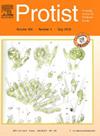Nivicolous myxomycetes in the French Pyrenees – A biodiversity study aided by two molecular markers
IF 2.1
3区 生物学
Q4 MICROBIOLOGY
引用次数: 0
Abstract
We report a systematic survey for nivicolous myxomycetes (Amoebozoa, Myxomycetes) carried out between April 30 and May 6 in the French Pyrenees (Hautes-Pyrénées, 900–2000 m). The 738 specimens were barcoded for the nuclear small subunit ribosomal gene (nucSSU, 652, 88.3 % successful). Trichia alpina, the only bright-spored species found, was not sequenced. Additionally, a section of the translation elongation factor 1-alpha gene (EF1A) was successfully sequenced for 496 specimens (67.2 %). The nucSSU phylogeny showed 31 dark-spored species as genetically distinct, yet not always monophyletic lineages. Two species, Polyschismium fallax and P. peyerimhoffii, were grouped in one clade, although differing in barcode sequences. These separations were confirmed by EF1A in all cases except Didymium pseudodecipiens, where EF1A sequences could not be obtained. The resolution for the species pair P. fallax and P. peyerimhoffii increased, and for Polyschismium chailletii two distinct clades were found, indicating a cryptic species complex. Based on the molecular clades, we describe in detail the corresponding morphological differences in four taxa (Didymium dubium and Didymium pseudodecipiens; Polyschismium chailletii groups a and C). The study confirms the reliability of barcoding via nucSSU with an independent second marker and delivers a barcoded, quality-checked comprehensive data set for the Pyrenees
法国比利牛斯山脉的乳头状黏菌——两种分子标记辅助下的生物多样性研究
我们报告了4月30日至5月6日在法国比利牛斯山脉(hautes - pyracimnsames, 900-2000 m)进行的一项系统调查。对738份标本进行核小亚基核糖体基因的条形码检测(nucSSU, 652, 88.3%成功)。唯一发现的亮孢子物种——高山毛癣菌(Trichia alpina)没有进行测序。此外,对496个样本(67.2%)的翻译延伸因子1- α基因片段(EF1A)进行了成功测序。nucSSU系统发育显示31个暗孢子物种在遗传上是不同的,但并不总是单系谱系。虽然在条形码序列上存在差异,但将两种植物归为一支系。这些分离在除Didymium pseudodecipiens外的所有病例中都得到了EF1A的证实,因为Didymium pseudodecipiens无法获得EF1A序列。对P. fallax和P. peyerimhoffii种对的分辨率提高了,对P. chailletii多裂属发现了两个不同的分支,表明存在一个隐蔽的物种复合体。基于分子进化枝,我们详细描述了四个分类群(Didymium duum和Didymium pseudodecipiens; Polyschismium chailletii类群a和C)相应的形态差异。该研究证实了通过nucSSU与独立的第二标记进行条形码的可靠性,并为比利牛斯山脉提供了条形码,质量检查的综合数据集
本文章由计算机程序翻译,如有差异,请以英文原文为准。
求助全文
约1分钟内获得全文
求助全文
来源期刊

Protist
生物-微生物学
CiteScore
3.60
自引率
4.00%
发文量
43
审稿时长
18.7 weeks
期刊介绍:
Protist is the international forum for reporting substantial and novel findings in any area of research on protists. The criteria for acceptance of manuscripts are scientific excellence, significance, and interest for a broad readership. Suitable subject areas include: molecular, cell and developmental biology, biochemistry, systematics and phylogeny, and ecology of protists. Both autotrophic and heterotrophic protists as well as parasites are covered. The journal publishes original papers, short historical perspectives and includes a news and views section.
 求助内容:
求助内容: 应助结果提醒方式:
应助结果提醒方式:


